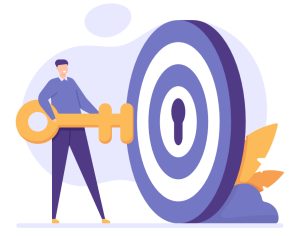Britain has a long-term issue with productivity. But Andy Haldane, chief economist at the Bank of England, said in a recent speech that a “lack of management quality is a plausible [explanation]”. In a bid to ramp up output, under-pressure managers are being seduced by the increasingly sophisticated technology cropping up that promises to track and analyse people’s behaviour while they’re in the office. According to Fairsail, a cloud-based HR software company, 79% of HR leaders in the UK believe all personnel decisions should be based on data and analytics but only 34% are managing to achieve this. But what’s the net effect and how open are most employees to having their employers know so much about them?
Of course people have to an extent been conditioned to be more comfortable with their data being tracked, albeit anonymously. Consumers are used to marketers using cookies to personalise their online experience, while the health conscious have been monitoring their sleep, heart rate and daily steps using fitness trackers for a while now. But although many are used to every element of their personal lives being scrutinised, this quantified, Fitbitised existence has really only just begun to seep into the workplace.
Encouraging the monitoring trend to take hold are a slew of analytics companies that promise to help managers make more informed decisions about their teams. They do this by using sensors to learn about everything from people’s stress levels to how long they spend in meetings. In fact, about 202 million wearable devices were given out by companies accross the globe in 2016 and ABI Research, the marketing company, believes that number will rise to more than 500 million by 2021. Humanyze, for example, has created digital ID badges that keep track of an employee’s movements and even the tone and volume of their voice. It then anonymously aggregates data to identify patterns like how much time an employee spends on the phone to customers versus the time they spend in meeting rooms with colleagues.
But it’s important to identify the right kinds of data to track. Enlightened managers realise that productivity goes beyond just bum-on-seat time and that an employee’s health, happiness and wellbeing play a role too. After all, research from Vitality Health, the insurance company, found that employee ill-health costs the UK economy £73bn a year in lost productivity. “Data allows you to catch issues around stress before they become a problem and affect performance,” says Ben Waber, Humanyze’s CEO. Other companies are also keen to optimise their offices for innovation and there’s a popular school of thought that suggests that the more employees bump into each other and have serendipitous conversations – Tony Hsieh, CEO of Zappos, the online shopping company, often talks about “collisionable hours” – the more likely they’ll be to come up with creative ideas.
For example, one of Humanyze’s clients discovered from its trackers that workers who spent more time interacting with colleagues were more productive. After introducing an extra break into the working day to allow people to socialise more, it found that productivity increased by 10%, the amount of stress in workers’ voices fell by 19% and staff turnover was slashed by 70%. “It’s not that useful to look at an individual person’s data but, in aggregate, you can derive some valuable insights that historically you would have had to pay for a consultant to uncover,” says Waber.
The trouble is while you may be able to spot CCTV cameras or even mystery shoppers, modern surveillance takes less conspicuous forms. It’s in the sensor under your desk, the software running in the background of your computer or perhaps built into the office furniture itself. And this might not sit well with everyone. Looking at perceptions of tracking technology at work, a study by PwC, the professional services company, found that only 46% of workers would accept a free piece of wearable technology if their employers had access to the data recorded. Four in ten said they don’t fully trust their employer to use their data for their benefit. “Early studies show that the potential advantages brought by digital surveillance are undermined by a number of disadvantages such as reduced trust in the organisation, lack of privacy and stress,” says Stella Martorana, research associate at the CIPD. “If employees feel like their privacy is being violated and don’t understand the reasons behind the monitoring, they may resist it.”
To understand the impact of these levels of monitoring, Jamie Woodcock, an ethnographer from the department of management at the London School of Economics, went undercover in a call centre and found that by monitoring breaks and calls to the second, staff often looked for novel ways to extend breaks and reduce their output without anyone finding out. “It’s an update on a very old fashioned school of management that believes that any moment a person’s not working they’re being unproductive,” he says. “Do you really need to know how they’re performing and how hard they’re working every second?”
And on top of the danger that more tracking could spur employees on to deliberately misbehave, Woodcock believes that being watched at all times can be incredibly stressful. “If you put people under that much pressure you may eek out a little bit more work but you also create awful working conditions, which might undo all the gains,” he said. “I can’t think of anything more stressful than a name badge that monitors you: it’s like the worst bits of 1984 writ large in the workplace.”
The rise of tracking technology could also be part of a wider distrust of employees and a growing culture of surveillance. A few years ago, Marissa Mayer, who was Yahoo’s chief executive at the time, raised eyebrows by coming out against flexible working because she wanted everyone to be visibly present. Meanwhile, Amazon allegedly tracks the movements of warehouse workers to the second in a bid to maximise their productivity and the Telegraph has reportedly used sensors to measure how much time people were spending at their desks.
However, some proponents argue that being able to compare their stats with top performing teams will motivate – not stress – employees. “We like to think of it as a Fitbit for your career,” says Waber. “If you know that top sales people spend 8% more time on the phone than you, for example, that’s objective data you can use to benchmark yourself rather than relying on opinions.”
But Woodcock’s not convinced that this sort of data is the way to get results. “How long you spend in meetings or on the phone is not what makes someone successful,” he says. “What works for one person may not work for another because people are individuals.” So rather than obsessing about numbers and disempowering people by introducing high levels of surveillance, managers should perhaps consider doing things the old-fashioned way and simply speak to their teams.
And the question of privacy remains, even when the data is anonymised and employers are only doing it with the best of intentions. Although the European Court of Human Rights ruled that an employer was within its rights to snoop on a worker’s Yahoo Messenger chats, data laws are starting to look out of date. Even the biggest champions of the quantified employee movement want governments to update legislation to reflect all the new ways that employers can collect data on staff. “The government needs to catch up and regulate rather than leave it up to employers or there’s a danger that they might misuse the technology,” Waber warns.
Beyond complying with data privacy laws, though, Woodcock argues for a more democratic working environment where people feel like they have a degree of autonomy. This is already happening in some workplaces. Felicitas Betzl, founder of Serps Invaders, a digital agency, says cutting the company’s working week to four days and being down with staff taking duvet days has actually boosted productivity, while Sidonie Warren, co-founder of Papersmiths, the stationary brand, believes that presenting the company’s finances – warts and all – to her team helps motivate them and show them the impact they can have. “Above all, workers should feel like they have a say in their company culture and should be treated like human beings,” concludes Woodcock. “Managers should think carefully before digitising people’s working lives or you start treating people like robots.” ![]()
Share via:








































